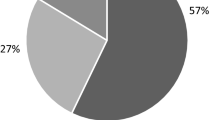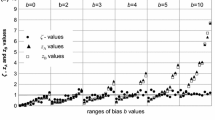Abstract
Guidelines are given for the evaluation of proficiency test (PT) results in order to increase the effectivity of PT participation. For better understanding, some statistical background is given along with some examples to show the effects of the choices made by the PT provider. The calculation method of the assigned value and the selection of the standard deviation both affect the z-score that is used by the participating laboratory to judge the quality of its performance in the PT. Therefore, the participating laboratory is advised to use the PT results with care and, if necessary, to recalculate the z-scores. Finally, advice is given on how not to follow up bad PT results along with some valuable steps that could be part of an effective follow-up procedure.


Similar content being viewed by others
References
Eurachem (2000) Selection, use and interpretation of proficiency testing (PT) schemes by laboratories Eurachem, http://www.eurachem.ul.pt/
ISO/IEC 17025 (2005), General requirements for the competence of testing and calibration laboratories, ISO, Geneva
EA-02/10, rev. 00 (2001), EA policy for participation in national and international proficiency testing activities, http://www.european-accreditation.org/
EA-03/04, rev. 01 (2001), Use of proficiency testing as a tool for accreditation in testing, http://www.european-accreditation.org/
ISO Guide 43-1 (1997), Proficiency testing by interlaboratory comparison. Part 1: Development and operation of proficiency testing schemes, ISO, Geneva
ILAC G13 (2000), ILAC Guidelines for the Requirements for the Competence of Providers of Proficiency Testing Schemes, ILAC, http://www.ilac.org
ISO 4259 (1992), Petroleum products: determination and application of precision data in relation to methods of test, ISO, Geneva
ISO 5725-4 (1994), Accuracy (trueness and precision) of measurement methods and results. Part 4: Basic methods for the determination of trueness of a standard measurement method, ISO, Geneva
ASTM E178 (2002), Standard practice for dealing with outlying observations, ASTM International, West Conshohocken, USA
ASTM E1301 (2003), Standard guide for proficiency testing by interlaboratory comparisons, ASTM International, West Conshohocken, USA
ISO/FDIS 13528 (2005), Statistical methods for use in proficiency testing by interlaboratory comparisons, ISO, Geneva
IIS04R01 (2004), Results of proficiency test crude oil IIS, http://www.iisnl.com
ISO 5725-2 (1994), Annex B3, Table B3, ISO, Geneva
IIS04C06 (2004) Results of proficiency test methanol IIS, http://www.iisnl.com
Lowthian PJ, Thompson M (2002) Analyst 127:1359–1364
AMC (2002) Understanding and acting on scores obtained in proficiency testing schemes, AMC Technical Brief 11, Royal Society of Chemistry, London
FAPAS (2002) Protocol, organisation and analysis of data, 6th edn., http://ptg.csl.gov.uk/fapasprotocol.cfm
IIS (2003) Protocol for the organisation, statistics and evaluation, version 3, IIS, http://www.iisnl.com
KDLL (1994) Report R94.012, KDLL, Zeist, NL
http://www.kiwa.nl/uploadedFiles/Kiwa_website/03_Water/020_Diensten/Toelichtingrapportage.doc
QM (2002) Statistical protocol, QM, Bury, UK
RIZA (1998) Procedure W 5003 8.301, RIZA, Lelystad, NL
Shell Global Solutions (2004) Shell main product correlation scheme, Shell Global Solutions, Amsterdam, NL, confidential communication
WASP (1996) Information book for participants, 4th edn. WASP, UK
van Montfort MAJ (1992) Statistical remarks on round robin data of IPE and ISE, Wageningen Agricultural University, Wageningen, NL
Author information
Authors and Affiliations
Rights and permissions
About this article
Cite this article
Visser, R.G. Interpretation of interlaboratory comparison results to evaluate laboratory proficiency. Accred Qual Assur 10, 521–526 (2006). https://doi.org/10.1007/s00769-005-0051-2
Received:
Accepted:
Published:
Issue Date:
DOI: https://doi.org/10.1007/s00769-005-0051-2




